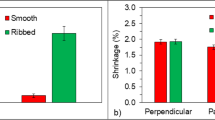Abstract
As soon as the gate solidifies or the nozzle is closed, the amount of melt inside a cavity remains constant. At this moment, the cavity deformation affects the final product shape and size. A set of simulation procedures has been developed in this study to estimate the cavity deformation which arises during an injection-molding process. A mold-filling program was applied to calculate the molding variables. The estimated cavity pressure, temperature distribution, and clamping force were employed as the boundary conditions in the mold-deformation analysis. A structural analysis program was developed to predict the cavity deformation. Molding experiments were carried out for polymethyl methacrylate (PMMA) wedge-shaped parts. To verify the structural analysis, a strain gauge was installed on the sidewall of the mold. The measured strains agreed with the simulated results. A commercial simulation software package was also used to predict the shrinkage and warpage of injection-molded parts. Numerical results showed the improvement in predicting the shape and size of a final product by taking the cavity deformation into account. The influences of the packing pressure, mold temperature, or melt temperature on shrinkage and warpage were also investigated.
Similar content being viewed by others
References
Choi DS, Im YT (1999) Prediction of shrinkage and warpage in consideration of residual stress in integrated simulation of injection molding. Comp Struct 47(1):655–665
Chang TC, Faison E (2001) Shrinkage behavior and optimization of injection molded parts studied by the Taguchi method. Polym Eng Sci 41(5):703–710
Su Y (2002) Analysis on the process parameter of light guide using injection compression molding. Masters thesis, Da-Yeh University, Taiwan
Pantani R, Speranza V, Titomanlio G (2001) Relevance of mold-induced thermal boundary conditions and cavity deformation in the simulation of injection molding. Polym Eng Sci 41(11):2022–2035
Leo V, Cuvelliez CH (1996) The effect of the packing parameters, gate geometry, and mold elasticity on the final dimensions of a molded part. Polym Eng Sci 36(15):1961–1971
Gahleitner M, Bihlmayer G, Sobczak R (1991) Modified Carreau model. Kunstst Ger Plast 81:54–55
AC Technology (1997) C-MOLD reference manual. Ithaca, New York, pp 2–4
Quach A, Simha R (1971) Pressure–volume–temperature properties and transitions of amorphous polymers; polystyrene and poly (orthomethylstyrene). J Appl Physi 42(12):4592–4606
Hieber CA, Shen SF (1980) A finite-element/finite-difference simulation of the injection- molding filling process. J Non-Newt Fluid Mech 7:1–32
Schlichting H (1968) Boundary-layer theory, 6th edn. McGraw-Hill, New York
Han K-H, Im Y-T (1997) Compressible flow analysis of filling and post-filling in injection molding with phase-change effect. Comp Struct 38(1–4):179–190
Cook RD, Malkus DS, Plesha ME, Robert JW (2001) Concepts and applications of finite element analysis, 4th edn. Wiley, New York
Author information
Authors and Affiliations
Corresponding author
Rights and permissions
About this article
Cite this article
Wu, CH., Huang, YJ. The influence of cavity deformation on the shrinkage and warpage of an injection-molded part. Int J Adv Manuf Technol 32, 1144–1154 (2007). https://doi.org/10.1007/s00170-006-0435-4
Received:
Accepted:
Published:
Issue Date:
DOI: https://doi.org/10.1007/s00170-006-0435-4




